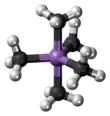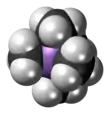Pentamethylarsenic
Pentamethylarsenic (or pentamethylarsorane[1])is an organometalllic compound containing five methyl groups bound to an arsenic atom with formula As(CH3)5. It is an example of a hypervalent compound. The molecular shape is trigonal bipyramid.[2]
.svg.png.webp) | |||
| |||
| Names | |||
|---|---|---|---|
| IUPAC name
pentamethyl-λ5-arsane | |||
| Identifiers | |||
3D model (JSmol) |
|||
| ChEBI | |||
PubChem CID |
|||
| |||
| |||
| Properties | |||
| As(CH3)5 | |||
| Molar mass | 150.097 g·mol−1 | ||
| Appearance | colourless liquid | ||
| Melting point | −6 °C (21 °F; 267 K) | ||
| Boiling point | >100 °C (212 °F; 373 K) | ||
| Structure | |||
| trigonal bipyramidal | |||
| 0 D | |||
| Hazards | |||
| Main hazards | explosive, flammable | ||
| GHS pictograms |   | ||
| GHS Signal word | Danger | ||
| H331, H301, H410 | |||
| Related compounds | |||
Related pentamethyl |
Pentamethylantimony; Pentamethylbismuth; Pentamethyltantalum; | ||
Except where otherwise noted, data are given for materials in their standard state (at 25 °C [77 °F], 100 kPa). | |||
| Infobox references | |||
History
The first claim to make pentamethylarsenic was in 1862 in a reaction of tetramethylarsonium iodide with dimethylzinc by A. Cahours.[3][4] For many years all the reproductions of this proved fruitless, so the production proved not to be genuine.[1][5] It was actually discovered by Karl-Heinz Mitschke and Hubert Schmidbaur in 1973.[6]
Production
Trimethylarsine is chlorinated to trimethylarsine dichloride, which then reacts with methyl lithium to yield pentamethylarsenic.[6]
- As(CH3)3 + Cl2 → As(CH3)3Cl2
- As(CH3)3Cl2 + 2LiCH3 → As(CH3)5 + 2LiCl
Side products include As(CH3)4Cl and As(CH3)3=CH2.[1]
Pentamethylarsenic is not produced by biological organisms.[7]
Properties
Pentamethylarsenic smells the same as pentamethylantimony, but is otherwise unique.[1]
The bond lengths in the molecule are for the three equatorial As−C bonds 1.975 Å and the two axial As−C bonds 2.073 Å.[8]
The infrared spectrum of pentamethylarsenic shows strong bands at 582 and 358 cm−1 due to axial C-As vibration, and weaker bands at 265 and 297 cm−1 due to equatorial C-As vibration.[9] Raman spectrum shows a strong feature at 519, 388, and 113 cm−1, and weak lines at 570 and 300 cm−1.[9]
Reactions
Pentamethylarsenic reacts slowly with weak acids. With water it forms tetramethylarsonium hydroxide As(CH3)4OH and trimethylarsenic oxide As(CH3)3O. With methanol, tetramethylmethoxyarsorane As(CH3)4OCH3 is produced. Hydrogen halides react resulting in the formation of tetramethylarsonium halide salts.[1]
When pentamethylarsenic is heated to 100° it decomposes forming trimethylarsine, methane, and ethylene.[10]
When trimethylindium reacts with pentamethylarsenic in benzene solution, a salt precipitates: tetramethylarsenic(V)tetramethylindate(III).[11]
References
- Hubert Schmidbaur (1976). Advances in Organometallic Chemistry. Academic Press. pp. 229–230. ISBN 9780080580159.
- Greene, Tim M.; Downs, Anthony J.; Pulham, Colin R.; Haaland, Arne; Verne, Hans Peter; Volden, Hans Vidar; Timofeeva, Tatjana V. (November 1998). "Molecular Structures of Pentamethylarsenic(V) and Trimethyldichloroarsenic(V) by Gas Electron Diffraction and ab Initio Calculations:? Molecular Mechanics Calculations on Pentamethylarsenic(V), Pentaphenylarsenic(V), and Related Compounds". Organometallics. 17 (24): 5287–5293. doi:10.1021/om980520r.
- Cahours, A. (1862). "Untersuchungen über die metallhaltigen organischen Radicale". Justus Liebigs Annalen der Chemie. 122 (3): 329–347. doi:10.1002/jlac.18621220305.
- Powell, P. (2013). Principles of Organometallic Chemistry. Springer. p. 135. ISBN 9789400911970.
- Wittig, G.; Torssell, K.; Vister, Thor (1953). "Über Pentamethyl-arsen und Pentamethyl-antimon". Acta Chemica Scandinavica. 7: 1293–1301. doi:10.3891/acta.chem.scand.07-1293.
- Mitschke, Karl-Heinz; Schmidbaur, Hubert (November 1973). "Pentamethylarsen". Chemische Berichte (in German). 106 (11): 3645–3651. doi:10.1002/cber.19731061124.
- Cornils, Boy; Herrmann, Wolfgang A. (2006). Aqueous-Phase Organometallic Catalysis: Concepts and Applications. John Wiley & Sons. p. 331. ISBN 9783527605460.
- Greene, Tim M.; Downs, Anthony J.; Pulham, Colin R.; Haaland, Arne; Verne, Hans Peter; Volden, Hans Vidar; Timofeeva, Tatjana V. (November 1998). "Molecular Structures of Pentamethylarsenic(V) and Trimethyldichloroarsenic(V) by Gas Electron Diffraction and ab Initio Calculations: Molecular Mechanics Calculations on Pentamethylarsenic(V), Pentaphenylarsenic(V), and Related Compounds". Organometallics. 17 (24): 5287–5293. doi:10.1021/om980520r.
- Greenwood, N. N. (1974). Spectroscopic Properties of Inorganic and Organometallic Compounds. Royal Society of Chemistry. p. 294. ISBN 9780851860633.
- Aylett, B. J. (2012). Organometallic Compounds: Volume One The Main Group Elements Part Two Groups IV and V. Springer Science & Business Media. p. 401. ISBN 9789400957299.
- "7.3.6.3". Science of Synthesis: Houben-Weyl Methods of Molecular Transformations Vol. 7: Compounds of Groups 13 and 2 (Al, Ga, In, Tl, Be...Ba). Georg Thieme Verlag. 2014. p. 258. ISBN 9783131779618.

